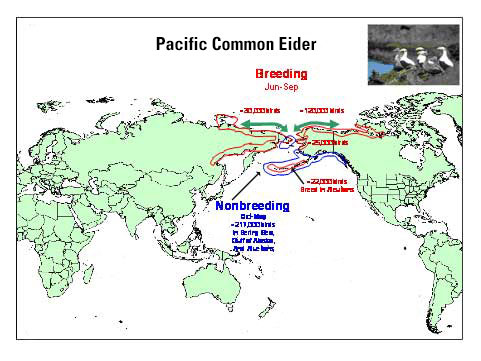Pacific Common Eider, Somateria mollissima v-nigrum
High-Priority Species ListCommon eiders are accidental in Japan (Brazil 1991) and common in the Sea of Okhotsk and along the Kamchatka Peninsula coast in winter (Dement’ev and Gladkov 1967). The breeding origins of these wintering birds are unknown, but are most likely from the closest known nesting areas in the western Aleutian Islands (Near, Rat and Andraenof islands), Commander Islands, and northeast Kamchatka Peninsula. Birds infected in Asia during winter and returning to North America to nest are most likely to be from the western Aleutian Islands and North Slope/northwest Canadian breeding populations.
Many samples will be from fresh fecal material deposited on eggs as the hen flushes; however, the relationship of the viral loads of cloacal and fresh fecal samples is unknown, but assumed to be strong. Thus, cloacal samples and fecal samples will be taken from 200 captured birds.
Locations, numbers, demographics, and timing of sampling
- Aleutian Islands, Near Islands, 200 samples. Samples from adult females will be collected in late-May to early June 2006 from Attu, Agattu, Nizki, and Alaid islands with 50 individuals per island from as many locations as possible on each island. All individuals will be nesting females early in incubation. Capture of 25 birds will be by nest trapping (mist netting, dip net, bow trap). Tracheal and cloacal swabs, blood plasma, and fecal samples will be taken from these eiders. The remainder (175) of the samples will be from fresh fecal samples deposited on eggs as the hen flushes.
- North Slope/Western Canadian Arctic, 200 samples. Samples of adult males and females shot at Barrow will be taken during May-June. Cloacal samples will be acquired from birds shot during spring migration by subsistence hunters.
- Aleutian Island, Andraenof Islands, offshore islets of Adak Island, 50 samples. Fresh fecal samples from nesting adult females will be collected in early to mid-June. Due to the relatively small number of nesting COEI, a larger sample size is unlikely.
- YKD, 400 samples. (1) Both cloacal and fecal samples of 100 nesting individuals and 50 fecal samples from additional hens will be collected at Kigigak Island (150 total individuals; 100 individuals fecal, 50 individuals fecal & cloacal), which has a large, relatively dense concentration (colony) of common eiders. (2) Fecal samples from 200 females representing the remaining central (coastal) Y-K Delta nesting population will occur at Baird Inlet (25 fecal), Tutakoke River (50 cloacal & fecal, 100 fecal), and the random plot surveys (25 fecal).
Other targeted species Significant numbers of spectacled eiders, black brant, and emperor geese are present at all sampling locations on the YKD. Although northern pintail and long-tailed ducks also nest in these areas, few nests are found each year and individuals not on nests are difficult to capture. Nesting Steller’s eiders are rarely found. King eiders are the most common eider shot during spring migration at Barrow and will be available for sampling.
Contact: Julian Fischer
Yukon Delta NWR (Yukon Delta NWR ground plot surveys, Tutakoke River, Kigigak Island,
Contact: Fred Broerman
Alaska Maritime NWR (Aleutian Islands - Near Islands & Adak Islets)
U.S. Geological Survey (Aleutian Islands - Near Islands)
Contact: Margaret Petersen
University of Nevada, Reno (Tutakoke River)
North Slope Borough (Barrow - North Slope/Western Canadian Arctic breeding birds)
Flint, V. E., R. L. Boehme, Y: V. Kostin, and A. A. Kuznetsov. 1984. A field guide to the birds of the USSR. Princeton University Press, Princeton, NJ.
Gabrielson, I. N. and F. C. Lincoln. 1959. Birds of Alaska. Wildlife Management Institute, Washington, D.C.
Goudie, R. I., G. J. Robertson, and A. Reed. 2000. Common Eider (Somateria mollissima). In The Birds of North America, No. 546 (A. Poole and F. Gill, eds.). The Birds of North America, Inc., Philadelphia, PA.
Kear, J., ed. 2005. Ducks, Geese, and Swans, Vol 2. Oxford University Press, Oxford.
Petersen, M. R. and P. L. Flint. 2002. Population structure of Pacific common eiders breeding in Alaska. Condor 104: 780-787.

Ranking Score: 10.0
Asian H5N1 ranking criteria for Pacific Common Eider, Somateria mollissima v-nigrum.
Total of partial contact with Asia1 |
Contact with known "hot spot"2 |
Habitat used in Asia3 |
Pop. in Alaska4 |
Can samples be obtained? |
Score |
2.0 |
1.0 |
2.0 |
3.0 |
2.0 |
10.0 |
Approx. 80,000 winter in Russia and breed in North America and 30,000 breed in northeastern Russia |
No known use of AI-infected areas |
Breeds in wet or moist tundra meadows near wetlands or on barrier islands. Winters in coastal waters |
Est. 120,000 in northern Alaska and western Canada, 25,000 in western Alaska, 20,000 in Aleutian Isls. |
Could be difficult to obtain at a few locations |

